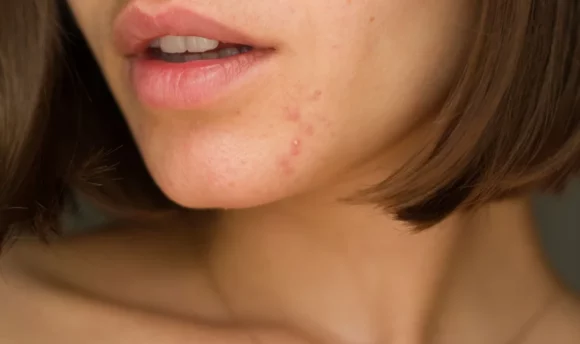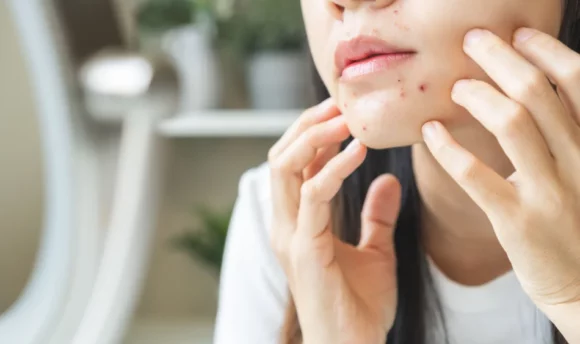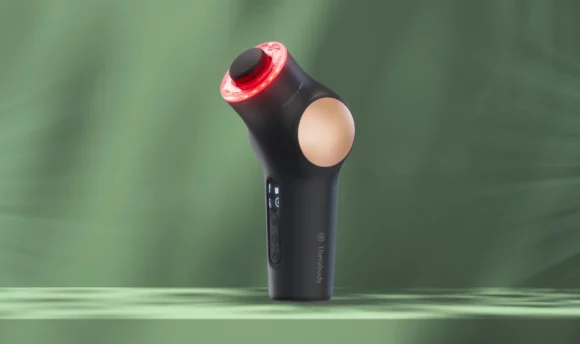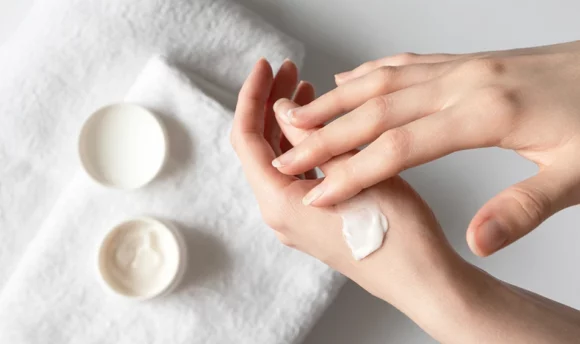Forehead Acne 101: Causes, Treatments, and Secrets
Decoding the mysteries of upper facial blemishes
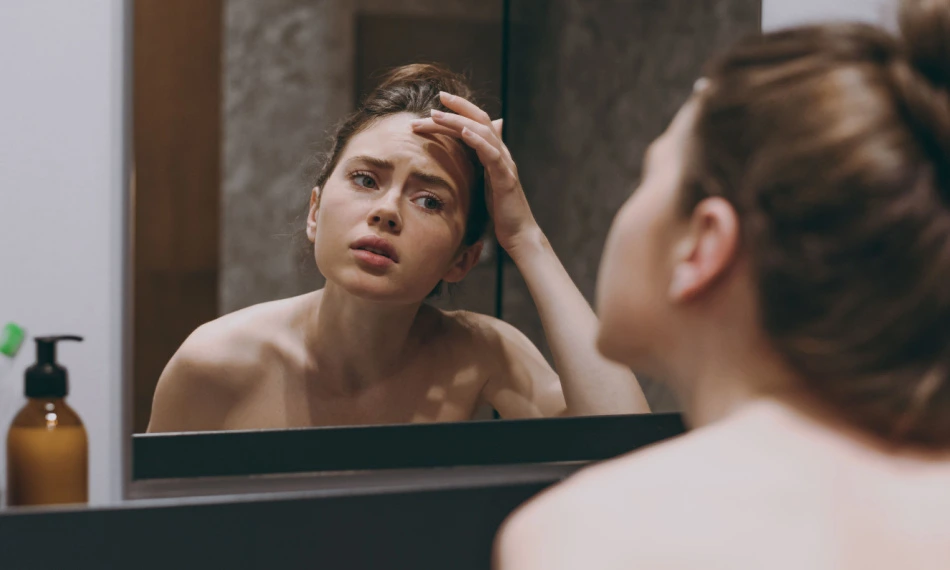
Affecting almost 10% of the global population, acne is one of the most common skin conditions in the world. The disorder manifests itself as small bumps on the face and body, which are not only physically painful but can also cause psychological distress for sufferers.
While these pesky pimples can pop up anywhere, they often appear on the forehead. But why is this, and how can you stop it from happening?
Read on to learn everything you need to know about forehead acne, including the best acne treatments and some key preventative measures for maintaining a healthy complexion.
What Is Forehead Acne?
The term forehead acne refers to the presence of pimples, blackheads, whiteheads, cysts, and nodules on the forehead. A common form of acne, it results from clogging of sweat pores and hair follicle openings by excessive oil and dead skin cells, as well as bacteria. Since the forehead is part of the T-zone, an area of the face with more oil glands, it is particularly prone to acne.
Forehead acne types
Not all breakouts are the same, and it’s important to identify which variety you’re suffering from if you’re hoping to treat acne on the forehead properly. The different types of acne are:
- Whiteheads (closed comedones) – Formed when clogged pores form a small white or yellow closed bump over the skin.
- Blackheads (open comedones) – Like whiteheads, blackheads are bumps that arise when excess oil or dead skin cells clog the pores. However, the skin over these bumps is open, and air exposure causes them to look black.
- Papules – Solid, cone-shaped red bumps on the skin that are inflamed. They are generally less than 1 centimeter in width.
- Pustules – Small white skin bumps that contain a yellow liquid called pus.
- Nodules – An abnormal tissue growth that develops beneath the skin as a hard lump.
- Cysts – Deep, inflamed, and pus-filled lesions that form beneath the skin’s surface. In addition to being painful, they can leave scars.
What Causes Forehead Acne?
Whether you have moderate or severe acne across the forehead, excess oil production has likely triggered your breakout. Here are the main factors that can cause forehead acne:
#1 Hormonal changes
Rising levels of androgens, sex hormones, in the body can cause the sebaceous glands to increase in size. These enlarged glands are more likely to produce excess oil, therefore causing acne.
This is most common for teenagers going through puberty but can also occur during menopause, pregnancy, or when hormones fluctuate as part of the menstrual cycle.
#2 Hair and skincare products
If you often notice acne breakouts along the perimeter of your forehead, it could be down to the hair products you’re using.
Although using oily hair products like shampoos, conditioners, and coconut oil can help prevent dryness, ensure that you properly get them out of your hair through thorough washing. Styling products like pomades, gels, and waxes can also leave your skin extra oily.
Cleansers, serums, moisturizers, and other treatments may cause skin irritation that leads to acne, especially for those with sensitive skin. Some skincare products contain comedogenic ingredients, meaning they clog pores and trigger excess sebum production.
#3 Diet
Although it isn’t a confirmed cause, research indicates that what you eat plays a role in acne development.
Foods that are high in sugar and refined carbohydrates contribute because they cause a rapid rise in blood glucose levels. This also triggers the rise of insulin levels, a hormone that helps move glucose out of the bloodstream, increasing the androgens’ activity.
Studies show that consuming dairy products like milk may also worsen moderate acne, particularly for teenagers.
#4 Stress
Evidence indicates that an increase in stress is linked strongly with more severe acne.
Emotional distress triggers the release of cortisol, the stress hormone, which boosts sebum production. This can clog pores and cause inflammatory acne on the forehead.
When under stress, your diet and sleep schedule are also affected, which also play key roles in controlling breakouts.
#5 Poor hygiene
Certain hygiene practices can contribute to forehead acne. Acne is not caused by uncleanliness, but lack of regular washing may result in an accumulation of oil, dirt, and dead skin cells, leading to clogged pores.
In addition, touching your face frequently can transfer oils and bacteria from your hands to your face, potentially aggravating acne. Maintaining a balanced skincare routine and avoiding touching your face is crucial for healthy skin.
#6 Sweat
While beads of sweat can cause blocked pores, they may also lead to skin irritation. As a result, your hair follicles will become inflamed, which triggers itchy forehead acne.
Wearing tight clothing, hats, and headbands can also increase sweat production in this area.
How to Treat Forehead Acne
Worried about treating acne? There are a variety of methods for getting rid of excess oil and dead skin cells from your forehead, including the following options:
Natural remedies
For mild acne, natural ingredients may be a good solution to calm the breakouts on your forehead. Although they can’t get rid of pimples overnight, we’d recommend trying:
- Tea tree oil – Contains a bacteria-fighting compound called terpinen-4-ol. Research suggests that it may be as effective in treating acne as benzoyl peroxide.
- Aloe vera – An anti-bacterial and anti-inflammatory agent that treats moderate acne on the forehead.
- Azelaic acid – Clears bacteria from the pores, reduces inflammation, and minimizes acne scars.
- Zinc –Zinc deficiency can cause forehead acne, so applying it topically or taking a supplement may treat acne symptoms.
- Retinoids – Vitamin A-based creams and serums like adapalene that prevent the formation of comedones and have anti-inflammatory effects.
There is no doubt that these treatments are effective, but you should always consult a healthcare professional before beginning any treatment, as individual responses can vary greatly.
Prescription treatment
If natural remedies don’t work, or your forehead acne is recurring, you should speak to a dermatologist. They may be able to prescribe you one of the following stronger treatments:
- Oral or topical antibiotics – Often combined with benzoyl peroxide to prevent antibiotic resistance, you can either apply antibiotics to the skin or take them by mouth to kill bacteria and reduce inflammation.
- Tretinoin – A type of retinoid that comes in a topical cream or gel. It helps to exfoliate, unclog pores, and stimulate the growth of new skin cells.
- Spironolactone – Often prescribed to treat high blood pressure, this medication is also used for women suffering from hormonal acne.
- Hormonal birth control – Birth control pills that contain hormones like estrogen and progesterone can help to balance androgen levels in the female body.
How to Prevent Forehead Acne
To stop spots popping up on your forehead in the future, try to practice the following habits each day:
#1 Maintain a consistent skincare routine
One of the best places to start when treating forehead acne is with a regular skincare routine.
Be sure to wash your face twice daily with a gentle cleanser containing only natural, soothing ingredients. Use a moisturizer, too, which will prevent your skin from drying out and producing excess sebum.
You can also access over-the-counter acne creams that contain spot-fighting ingredients. For instance, benzoyl peroxide kills bacteria, and salicylic acid is an anti-inflammatory beta-hydroxy acid that manages oils.
Niacinamide is another great treatment for inflammatory acne when combined with salicylic acid, benzoyl peroxide, or retinoids.
#2 Exfoliate
Along with using a gentle cleanser, exfoliation is an essential part of any skincare routine for acne-prone skin. Scrubbing at your skin can cause further inflammation, so we’d recommend using a chemical exfoliant to remove dead cells that bacteria thrive on.
For best results choose skincare products with glycolic, lactic, or salicylic acid.
#3 Use non-comedogenic products
As we’ve discussed, forehead acne is often caused by clogged pores. The best skincare products for preventing acne are therefore those that are labeled non-comedogenic or water-based, meaning they won’t block your hair follicles.
Along with skincare, you should also try to choose hair products that exclude oil.
#4 Watch your diet
Improving your diet can make a huge difference to your skin situation. For example, avoiding anti-inflammatory, highly processed, sugary foods can stop your skin from producing excess oil.
Instead, include a variety of healthy foods in your diet, such as fruits and vegetables, whole grains, legumes, lean proteins, and small amounts of healthy fats.
#5 Try to manage stress
High cortisol levels increase the risk of forehead acne, so it’s crucial to try to reduce stress where possible.
Along with eating a balanced diet, try to incorporate some healthy habits into your routine. Regular exercise can help you let off some steam, while simply getting outside for a walk is associated with lower stress levels.
Practicing mindfulness through meditation or simple acts like daily journaling has also been shown to reduce anxiety and stress.
#6 Seek professional advice
Finally, the most effective preventative measure is to consult a doctor or dermatologist. Using their expert knowledge, they can advise you on the best acne treatment for your skin, along with the key lifestyle changes that you can make to boost your overall skin health.
Advice From Our Medical Team


Acne vulgaris is a skin disorder that most commonly occurs during adolescence, affecting approximately 85% of people aged 12 to 24. However, more than 25% of women and 12% of men in their 40s still battle with the condition.
Unfortunately, recurring pimples anywhere on the face or body can cause redness and inflammation, as well as psychological effects. For instance, studies highlight the link between acne and anxiety, depression, and anger.
One way to minimize the appearance of acne and brighten your complexion is by consuming more antioxidant foods. Add berries, leafy greens, beets, walnuts, chia seeds, lentils, and green tea to your daily diet.
FAQs
Acne duration varies widely based on severity and individual skin characteristics. Acne spots that are mild may fade relatively quickly, usually within a few days, but there isn’t a set timeframe. Acne with more severe symptoms, such as moderate pimples or deep cysts, typically persists longer and heals more slowly.
Popping spots can transfer bacteria from your fingers onto your face, which may cause a skin infection. Pimple popping can also leave permanent scars and active breakouts will take longer to heal, so this practice isn’t safe.
Yes, eating fewer refined carbohydrates, sugary foods, processed meals, and dairy products can contribute to the reduction of acne.
Stress releases cortisol, a hormone that can trigger excess sebum production and clog pores. Being stressed may also cause you to make unhealthier lifestyle choices in terms of diet and sleep, which can also contribute to worsening acne.
Oily makeup can clog the pores and encourage acne to become worse. To avoid this, ensure that you are properly removing your makeup from the forehead area each day.
Conclusion
From hormones to haircare, forehead acne can be triggered by a range of factors. Fortunately, with the right treatments, a good skincare routine, and proper hygiene, spots don’t have to be a permanent feature of your face.
If you’re struggling to get rid of forehead acne, seek professional advice from your doctor or dermatologist.

















































 Select your language:
Select your language: 




